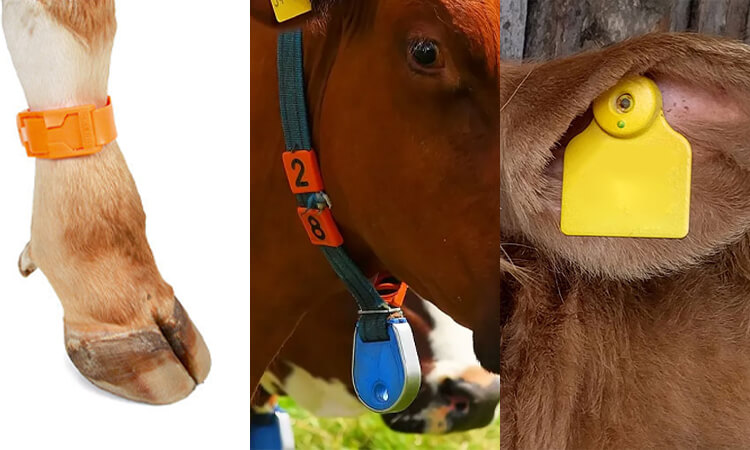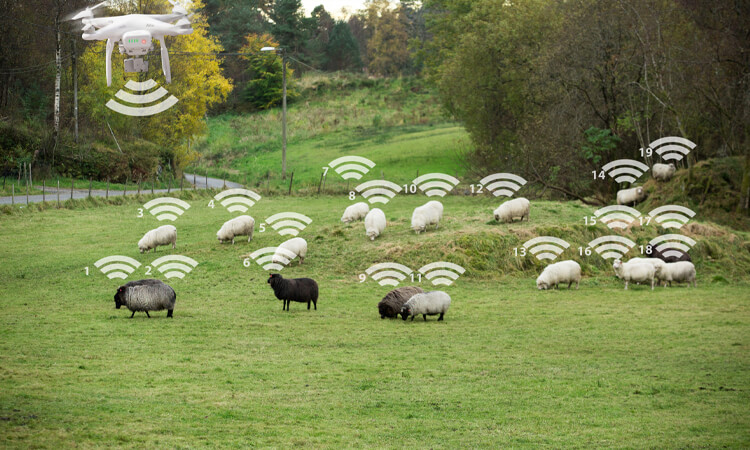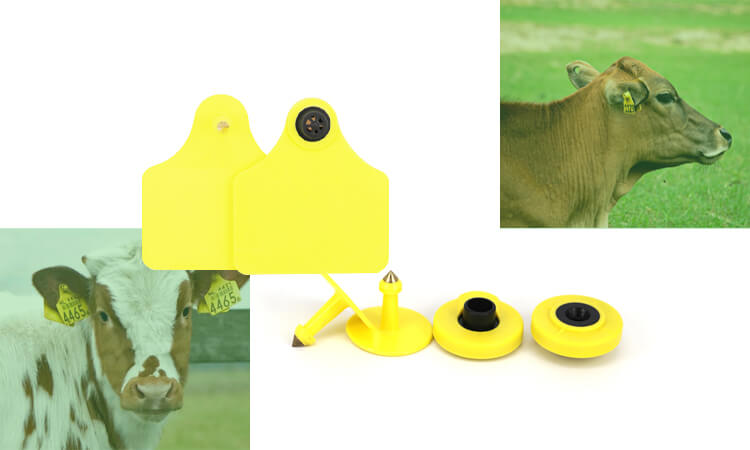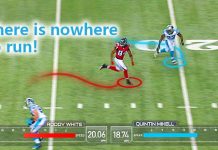RFID tags are a great way to track your livestock. This is especially useful if you have multiple farms or want to know exactly where your animals are at all times. In this article, we will explain why we must tag cattle and benefits of using RFID tag for cattle.
What is an RFID Tag for Livestock?
An RFID tag for livestock is a small electronic device used to identify and track individual animals in the livestock industry. The tag consists of a small microchip and an antenna attached to a plastic or metal tag. The tag can be attached to the animal’s ear or another part of its body for easy identification.
The RFID tag for livestock is part of an overall system known as electronic identification (EID), which is used to improve the traceability and management of livestock. The EID system includes RFID tags, readers, and software that can track individual animals throughout their life cycle, from birth to slaughter.
Livestock RFID tags can store animal information, such as breed, age, gender, and medical history. This information can be retrieved by scanning the tag with an RFID reader, enabling farmers and ranchers to manage their herds more effectively and make informed decisions about breeding, feeding, and healthcare.
There are three main types of RFID cattle tags:

- Ear tags for cattle: These come in various sizes, shapes, and styles. The tag’s size depends on the animal’s size and can be used on both large and small breeds. Some ear tags are made of aluminum or plastic, while others are stainless steel.
- Neck tags for cattle: Neck tags can also be made out of aluminum, plastic, or stainless steel, but they’re generally smaller than ear tags because they’re placed closer to the ground where there is less space available to place them on an animal’s body. They may also have longer-lasting batteries than earrings because they don’t move around as much as ears do, which improves battery life greatly over time.
- Leg Tags For Cattle: Leg Tags work by being surgically implanted into an animal’s leg during their first year after birth (or possibly even earlier, depending on what kind) so that when it comes time later down the road, like once again when those same animals reach maturity age then these already existing devices will already be present at this point making it easier.
The following video introduces an animal tag that can be injected into animals:
How Do I Use an RFID Tag for My Cattle?
Tagging cattle is a very easy process. It’s quick and easy to tag cattle, and the tagging process is simple, safe, and painless.
Here’s how:
- Step 1: Clean your hands and put on gloves. The tagger itself is sterile, but you don’t want to contaminate it by touching it with dirty fingers.
- Step 2: Select the correct tagger for your animal. The right size is key to getting a good reading, so make sure you choose the right model!
- Step 3: Insert the correct tag into the tagger and pin it closed at the top to ensure no air gets inside while tagging your cow.
- Step 4: Locate the vein in your cow’s neck, and place the end of the tagger over it. Hold tight!
- Step 6: Press a button on the tagger to read your cow’s data. The tagger will beep, and you’ll see a blood pressure reading on the display screen.
- Step 7: Pull back on the lever to release the needle and remove any air bubbles that may have formed inside the cow’s vein while you were tagging it.
- Step 8: Press another button on top of the tagger to eject your data card and send it into space!
You should be aware of the following when it comes to using an RFID tag for your cattle:
- RFID tags are not a substitute for ear tags. If you’re planning on using an RFID tag, the animal would still need a visible permanent ID (such as an ear tag or tattoo) to be identified.
- They are not designed to track location. Although they can identify animals, they do not provide GPS coordinates, so you don’t know where exactly the animal is at any given time. This is why most farmers use them alongside other forms of identification that provide this information. Either with another form of tracking (ear tags) or manually entering each animal into their records every time they move between fields or pastures on their farm – which isn’t always practical if there are hundreds/thousands of them!
- They cost more than traditional identification methods such as ear tags and tattoos because they require additional equipment like readers/scanners, which cost money upfront before any benefits can be seen from using this type of technology–. In contrast, traditional methods don’t require any additional investment beyond what has already been spent on buying all initial equipment before implementing these new technologies onto existing farms!
What is the Best Way to Tag Cattle?
Cattle tagging is essential for tracking and identifying individual animals. There are different methods of tagging cattle, but the best approach depends on several factors, including the herd size, management practices, and the purpose of tagging.
- Use ear tagging. Animal livestock ear tags involves attaching a tag to the ear using a unique applicator. Ear tags are durable, visible, and easy to read, making them an ideal choice for large herds. However, they can cause discomfort and irritation to the animal and may get lost or torn out.
- Use RFID tagging. It uses radio waves to transmit data stored on a microchip implanted under the animal’s skin. RFID tags are more expensive than ear tags but offer several advantages. Including accurate and automatic identification, real-time monitoring, and compatibility with electronic systems.
- Use Tattooing. This involves injecting ink into the animal’s ear or skin. Tattoos are permanent, visible, and tamper-proof, making them a reliable choice for individual identification. However, they can be time-consuming and require skilled personnel to apply.
- Use a combination of tags to maximize the benefits of each method, such as ear tags and RFID tags. This approach allows for multiple layers of identification and tracking, which can be useful for disease control, genetic management, and traceability.
The following video introduces RFID animal ear tags for farm cattle management systems:
Benefits of Cattle RFID Tag
RFID tags can be used to track cattle in a variety of ways, and it also has many advantages.

Improved Animal Health
By knowing where each animal is at all times, you can ensure that if one falls ill or needs medical attention, it will be easy to locate and help without wasting time searching through other herds or pastures. This will improve herd health by making sure all animals receive appropriate veterinary care when necessary.
RFID tags make it easy for you to find where each animal is at any time during the day or night; this will help you manage your herd more effectively by ensuring they don’t stray beyond the boundaries of their pasture (if there are any). You’ll also be able to monitor when they eat, sleep and visit the bathroom using special software that comes with most RFID systems.
Less Waste
You’ll reduce your waste using RFID tags because they make it easy to locate and help without wasting time searching through other herds or pastures. This will improve herd health by making sure all animals receive appropriate veterinary care when necessary. Less wasted feed and space. You can also save money using RFID tags because they reduce the amount of food wasted due to lost animals during grazing periods; there’s no need to worry about them wandering off somewhere else when they’re tagged! Additionally, you’ll save space in feed lots since there won’t be as many loose ends eating up more than their fair share.
Whether on a farm, ranch or in the livestock business, RFID tags are an easy way to keep track of your cattle. Using these small chips embedded into a tag and attached to each animal’s ear or leg, you can quickly track which animals belong to you and where they’ve been. This is especially important if your cattle carry valuable genetics that allows them to produce more meat than their peers when they are raised for slaughter.
There are several places where you can buy RFID tags for use with cattle:
- Online at websites like Amazon or eBay. If you’re looking for something basic that will work with most readers, this may be the best choice for ease of use and convenience. However, it might not offer all the features needed for advanced trackings, such as automatic data collection from multiple locations simultaneously (e.g., feeding silos).
- Local feed stores, farm supply stores, or hardware stores. Tend to carry fewer options but may have what customers need at reasonable prices without waiting weeks before receiving shipments via mail order delivery services like FedEx/UPS shipping companies across America today!
- Local retail stores such as Walmart, Best Buy, or even Costco. These stores usually carry basic RFID tags that will get the job done. Still, they may not offer all the features needed for advanced trackings, such as automatic data collection from multiple locations simultaneously (e.g., feeding silos).
Can I Use It On A Pig Or Other Animal Besides A Cow?
An RFID tag can be used on any animal. You may not have heard about it being used on pigs or other animals because there aren’t many manufacturers that make them for them. You can find them, but they are expensive and not as convenient to use as they are with cows. However, if you raise a variety of animals at your farm and want to keep track of how much food they need or which type is selling the best, then RFID tags are equally effective for any animal whose information you want to track.
You’ll need a special reader that reads the tags (and some will only read certain types), but once you have one in place and set up correctly with all the necessary software installed on your computer or tablet/phone, it’ll work as it does for cows! Just attach antennae near where the feeders are so that each time an animal comes by and eats from one of those feeders, their information gets written down somewhere else. So you know which ones were using what feeder during what times, when something might happen later down the road that needs fixing before another sale, occurs again later next year, etcetera.
The same goes for horses, sheep, goats, and other animals that you raise on your farm. You can use RFID tags in the same way as cows if you want to.
What is the Average Cost of an RFID Ear Tag?
The cost of an RFID tag for cattle depends on several factors, but it’s typically less than $1.00 per tag. The initial cost will depend on the type of tag you purchase and how many tags your animals need.
For example, if you’re purchasing a single-use RFID tag for each animal in your herd, and this includes a starter kit (tags, readers, software), then the average cost per cow is around $10 per cow. The main reason for this high price point is that most data collection systems require multiple readers throughout the entire barnyard. One reader doesn’t do much good without another one nearby to collect data from more cows at once!
The RFID tag is a useful tool for ranchers. It allows you to track your cattle and ensure they are healthy and safe. The device can also warn you if an animal is moving too far from its herd mates, helping prevent disease spread among livestock. With this new technology, you can improve your ranching operation in more ways than one!
Video Source: Official Vermont Government Website
General Q&A About RFID Tag for Cattle
-
How does an RFID tag work for cattle?
An RFID tag for cattle contains a microchip that stores a unique identification number, which is transmitted to an RFID reader using radio waves.
-
How are RFID tags for cattle implanted or attached?
RFID tags for cattle can be implanted or attached using various methods, including ear tagging, subcutaneous tagging, and rumen bolus ingestion.
-
How can RFID tags for cattle be used for tracking and tracing?
RFID tags for cattle can be used for tracking and tracing by recording an animal’s movements and medical history. This can be useful in disease outbreaks and food safety investigations.
-
How can RFID tags for cattle be integrated with other systems?
RFID tags for cattle can be integrated with other systems, such as herd management software and veterinary recordkeeping systems, through APIs and software integration.
-
How can RFID tags for cattle be used for disease management?
RFID tags for cattle can be used for disease management by allowing for more accurate tracking and tracing of animals in the event of a disease outbreak.
-
What is the regulatory environment for RFID tags for cattle?
The regulatory environment for RFID tags for cattle varies by country and region. The USDA requires that all cattle be identified with an official ear tag or other approved identification device in the United States.
-
How can RFID tags for cattle be used for genetic testing and breeding programs?
RFID tags for cattle can be used for genetic testing and breeding programs, allowing for more accurate tracking of individual animals and their genetic traits.











